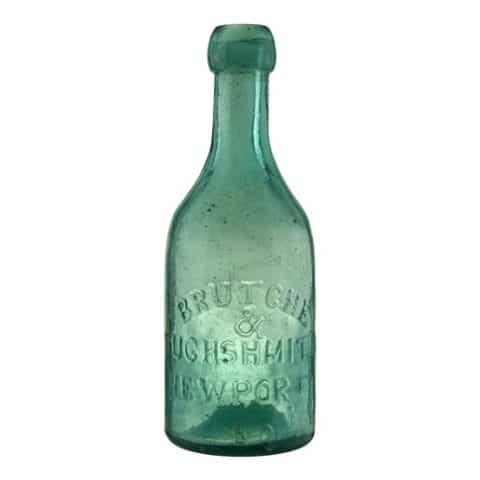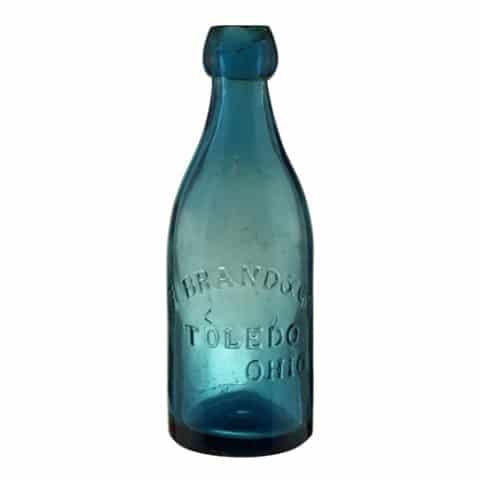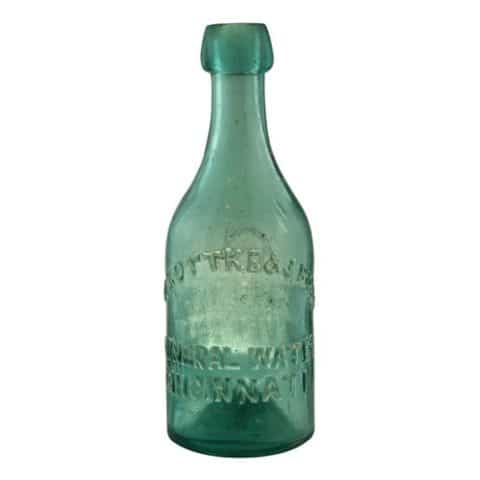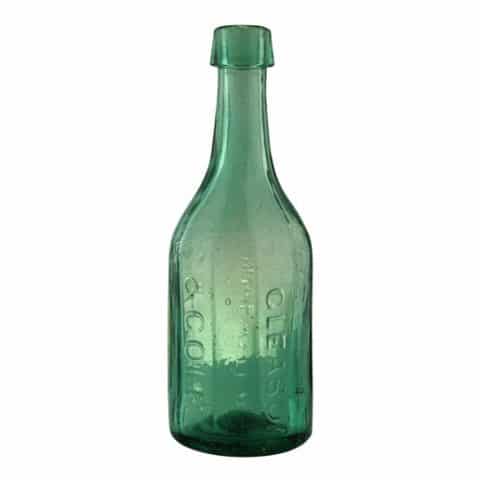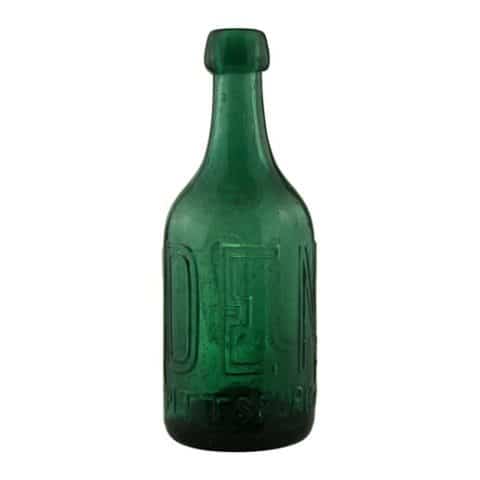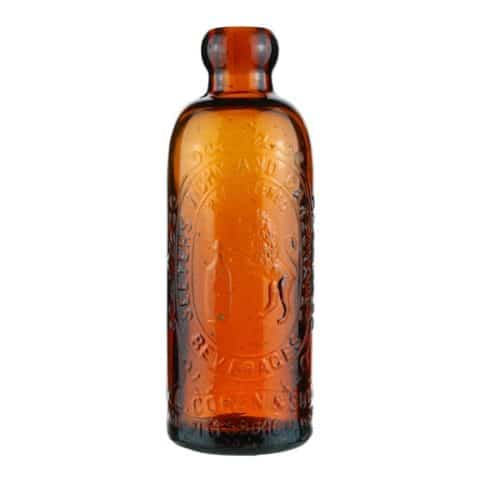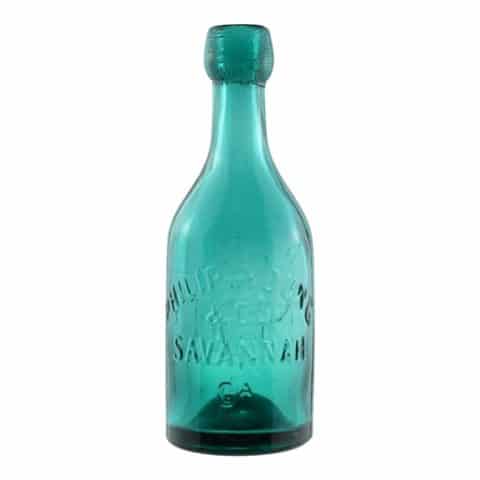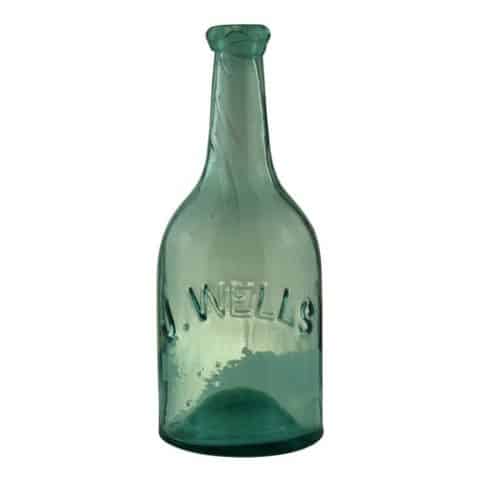Geo. H. Tobey Cincinnati
Geo. H. Tobey
Cincinnati
T
George H. Tobey, Cincinnati, Ohio
Green Aqua Soda
Provenance: Doug Shutler Collection

George H. Tobey is known for a couple of glass and stoneware bottles that he used in the late 1840s. This includes our subject museum soda bottle embossed ‘GEO. H. TOBEY’ arched over a horizontal “CINCINNATI.’ On the reverse of the bottle is a large embossed serifed ‘T.’ The 7-3/8” tall bottle has an applied sloping collar mouth and an improved pontil.

Tobey also used a similar soda bottle embossed ‘GEo. H. TOBEY’ arched over a horizontal ‘BOTTLER’ (2nd line) and ‘CINCINNATI’ (3rd line). The ‘o” in “GEo” is lower case and raised. On the reverse of the bottle is a large embossed serifed ‘T.’ The 7-¼ x 2 5/8″(3-¼) bottle has an applied tapered collar mouth and an improved pontil. A blue aqua example is pictured above.

George H. Tobey is also known for his 10-sided blue soda bottles embossed, ‘KNICKERBOCKER’ (side 1,), ‘MINERAL SODA WATER’ (side 3), ‘MANUFACTURED BY’ (side 5), ‘G. H. TOBEY’ (side 7) and ‘CINCINNATI’ (side 9). All of the other panels are blank. There is an applied tapered collar and an iron pontil. The bottle is considered very rare and measures approximately 7-½ x 2 5/8 (3 ½). It can be found in deep sapphire blue and cobalt blue glass. An example is pictured above.

Before soft drinks, there was a large mineral and soda water industry in the United States, mostly populated by regional manufacturers. Water quality was a huge concern in the antebellum days of cholera epidemics. Mineral or soda water was considered safer than well or other flowing water.
The difference between ‘soda water’ and ‘mineral water’ during the 19th century was often vague. Soda water was generally considered flavored artificial mineral water with the purposeful addition of carbonation and various compounds and flavoring. Mineral or spring water as it was also called, would generally be natural waters from spring sources that were typically highly mineralized with carbonates like alkaline, sulfurous compounds, and or various salts which often carbonated naturally. The confusion sometimes arises when mineral water was used as a generic term applied to various natural and artificially carbonated, non-artificially flavored waters including many utilized for their perceived medicinal qualities. Please visit the museum Spring & Mineral Water Gallery.
George H. Tobey was born on April 4, 1822, in West Stockbridge, Berkshire County, Massachusetts. The 1850 United States Federal Census indicates, “George Tobey, age: 28, birth: abt 1822, birthplace: Massachusetts, home in 1850: Cincinnati Ward 8, Hamilton, Ohio, occupation: Brewer, industry: Beverage Industries, others: Jane Tobey 21, James Tobey 17.”
Tobey was married to Jane Lewis Gray (1829-1902). Their children were Henry Tobey (unknown–1854), Mary L. Tobey (1850-1851), William T. Tobey (1852-1854), and Charles L. Tobey (1856-1894). It is tragic to note that three of the four children died within two years of birth. George Tobey himself would die on September 6, 1856. He was only 34 years old.
Besides the 1850 census and death records, we find very few references for George H. Tobey other than a “Durfee & Tobey mineral water” listing in the 1849 William’s Cincinnati Directory. Tobey’s partner was James H. Durfee and they were located on the southeast corner of 7th and John Streets.

There were also small notices placed in 1847 through 1849 Cincinnati Enquirer newspapers that read, “Durfee & Tobey – Dealers in Refined Cider and Pure Vinegar, warranted equal to any in this or any other market, which we will deliver, free of charge, in any part of the city at 10 cents per gallon, or by the bbl.”
James Durfee may have moved to Cincinnati around 1843 from Rochester, New York. In 1844, he is listed as Nash & Durfee, cider and vinegar warehouse, Reynolds st. (in the rear of No. 16 West Front street, between Main and Walnut) and in 1846, James Durfee, cider and vinegar merchant, W s Walnut, bet Front and 2d.

It is reported that there is a 9 5/8″ tall, 10-sided pottery Cronk-style bottle inscribed ‘TOBEY’S KNICKERBOCKER ROOT BEER.’ There is a similar pottery container inscribed ‘J. H. DURFEES KNICKERBOCKER ROOT-BEER’ that is pictured above.
George H. Tobey is not listed in the early 1850s Cincinnati directories up until his death in 1856.
Primary Image: Geo. H. Tobey Cincinnati bottle imaged on location by the FOHBC Virtual Museum midwest studio led by Alan DeMaison.
Support: Reference to Soda & Beer Bottles of North America, Tod von Mechow
Support: Reference to The American Pontiled Soda Database Project
Join the FOHBC: The Virtual Museum is a project of the Federation of Historical Bottle Collectors (FOHBC). To become a member.
















